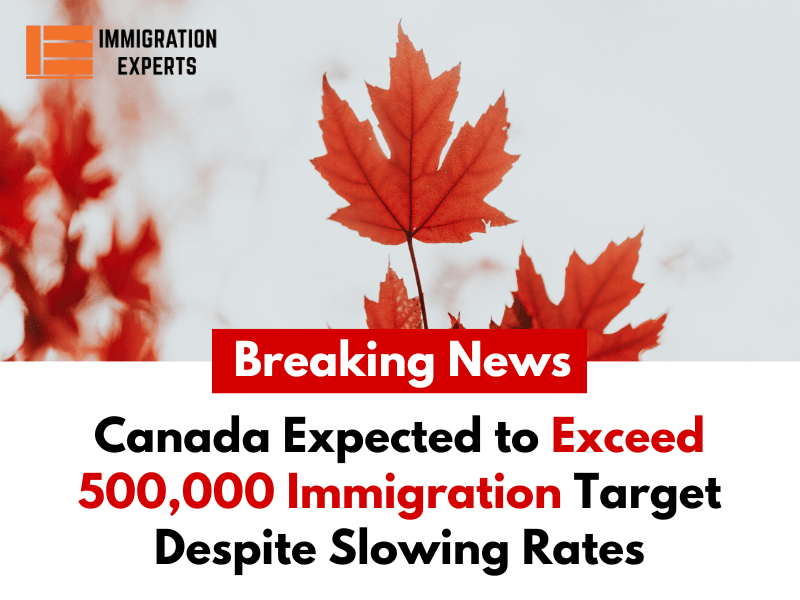051 8439995, 042 35911332

After experiencing two months of consecutive increases in immigration to Canada, the number of new permanent residents entering the country slightly declined in June.
According to recent data from Immigration, Refugees and Citizenship Canada (IRCC), Canada welcomed 44,540 new permanent residents in June, representing a 4.9% decrease compared to May.
Even with this small drop, Canada is still expected to have a record-breaking year for immigration, with forecasts suggesting that the country may exceed its 2024 targets.
Things You Will Find In This Page
A Year of Consistent Growth with a Mid-Year Decline
The year started with a slow increase in immigration, with just 34,870 new permanent residents arriving in March.
However, April and May saw a substantial rise, bringing in 42,595 and 46,835 newcomers, respectively.
This upward movement sparked optimism that Canada might meet or even surpass its ambitious immigration targets for the year.
Although June experienced a slight decrease to 44,540 new permanent residents, this drop doesn’t significantly impact the overall positive trend for the year.
If this pattern continues, Canada could welcome approximately 511,410 new permanent residents by the end of 2024.
This would mark an 8.4% increase compared to the 471,815 new permanent residents in 2023, which had already set a record for Canadian immigration.
Furthermore, the estimated 511,410 new permanent residents would surpass the government’s target of 485,000 for 2024, as outlined in the 2024-2026 Immigration Levels Plan.
Canadian Immigration Exceeding 2025 and 2026 Targets
This level of immigration would also exceed the goal of 500,000 new permanent residents set for both 2025 and 2026.

However, it’s important to remember that monthly immigration figures can fluctuate significantly due to various factors, such as seasonal trends, global events, and policy adjustments.
The slower start earlier in the year has resulted in a total of 255,700 new permanent residents for the first half of 2024, which is 2.9% less than the 263,420 recorded during the same period in 2023.
Ontario Remains the Top Destination for New Immigrants
Ontario, the most populous province in Canada, remains the top choice for newcomers.
In the first half of 2024, 106,500 new permanent residents settled in Ontario, making up over 41.6% of all newcomers to the country during this period.
The province’s appeal can be credited to its strong economy, diverse employment opportunities, and well-established immigration pathways.
Ontario’s appeal to immigrants is strengthened by several economic immigration programs, such as the Ontario Immigrant Nominee Program (OINP), the Canadian Experience Class (CEC), and the Federal Skilled Worker (FSW) program.
These programs helped bring in 56,155 new permanent residents to Ontario in the first six months of 2024, accounting for about 52.7% of all new permanent residents in the province.
In addition to economic immigrants, Ontario also admitted 25,610 new permanent residents through family sponsorships and 19,755 through Canada’s refugee and protected person programs from January to June.
Province-Wise Immigration Across Canada
While Ontario continues to be the primary destination for new immigrants, other provinces and territories also played significant roles in attracting permanent residents during the first half of 2024.
Here’s an overview of the figures:
| Province/Territory | New Permanent Residents |
| Ontario | 106,500 |
| British Columbia | 34,530 |
| Alberta | 34,375 |
| Quebec | 30,315 |
| Manitoba | 13,420 |
| Saskatchewan | 13,015 |
| New Brunswick | 8,890 |
| Nova Scotia | 8,330 |
| Newfoundland and Labrador | 3,020 |
| Prince Edward Island | 2,495 |
| Yukon | 535 |
| Northwest Territories | 230 |
| Nunavut | 25 |
| Not Specified | 20 |
| Total | 255,700 |
Among these provinces and territories, only Newfoundland and Labrador, Quebec, and Ontario reported increases in immigration numbers in June.
Newfoundland and Labrador experienced a 3.7% increase in new permanent residents, Quebec saw a 2.4% rise, and Ontario had a modest increase of 0.1%.
Newfoundland and Labrador: An Emerging Destination
Newfoundland and Labrador, the easternmost province in Canada, has been growing in popularity among immigrants. In June, the province saw a 3.7% increase in new permanent residents, reaching a total of 3,015 for the first half of the year.
This increase is particularly notable for a province with a smaller population and highlights the growing appeal of Atlantic Canada as a destination for newcomers.
The Atlantic Immigration Program (AIP) has played a key role in this growth, providing a pathway to permanent residency for skilled workers and international graduates who are eager to live and work in Atlantic Canada.
Quebec: A Unique Approach to Immigration
Quebec, Canada’s French-speaking province, saw a 2.4% increase in new permanent residents in June.
In the first half of 2024, the province welcomed 30,315 newcomers.
Quebec manages its immigration system, independently of the federal system, with a strong emphasis on attracting French-speaking immigrants.

Programs like the Quebec Skilled Worker Program (QSWP) and the Quebec Experience Program (PEQ) are specifically designed to address the unique needs of Quebec’s labor market and cultural environment.
Immigration Trends in Alberta and British Columbia
Alberta and British Columbia remain top destinations for immigrants, welcoming 34,375 and 34,535 new permanent residents, respectively, in the first half of 2024.
These provinces are favored for their robust economies, diverse job markets, and appealing lifestyles, making them popular among newcomers. However, recent reports indicate a rise in unemployment in Alberta, potentially linked to the increasing influx of immigrants.
In Alberta, the Alberta Advantage Immigration Program (AAIP) has played a crucial role in attracting skilled workers and entrepreneurs to the province.
Similarly, British Columbia’s Provincial Nominee Program (BC PNP) has been effective in drawing immigrants who contribute significantly to the province’s economic growth.
Temporary Immigration and Future Projections
Although permanent immigration is a major focus, temporary immigration to Canada has also experienced notable growth, especially during the COVID-19 pandemic.
This increase has been driven by programs like the Temporary Foreign Worker Program (TFWP) and the International Mobility Program (IMP).
Immigration Minister Marc Miller has announced that temporary immigration will soon have its dedicated immigration levels plan, set to be released in September.
This new plan is expected to address how to balance temporary and permanent immigration, ensuring that Canada’s immigration system remains effective and aligned with the country’s economic requirements.
What to Expect for the Remainder of 2024?
As Canada enters the second half of 2024, the country is poised to exceed its immigration targets for the year.
However, several factors could impact the final figures, including the introduction of the new temporary immigration levels plan and potential changes in federal and provincial policies.
Despite a slight decline in June, Canada’s immigration system remains a vital component of the country’s population growth and economic success.
With robust immigration programs and ongoing interest from individuals seeking new opportunities, Canada is well-positioned to retain its status as a leading destination for immigrants.
As the year progresses, attention will be focused on the monthly immigration figures to determine if Canada can sustain its current momentum and achieve another record-breaking year for welcoming new permanent residents. Whether through economic pathways, family sponsorships, or refugee protection, Canada’s dedication to immigration remains strong, helping the country thrive in an increasingly interconnected world.
